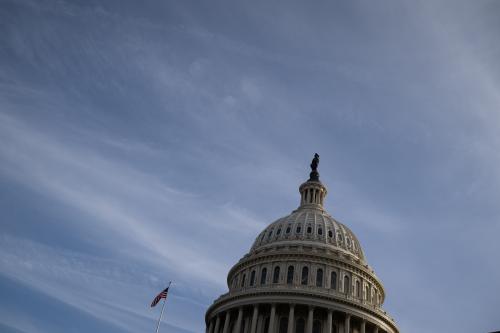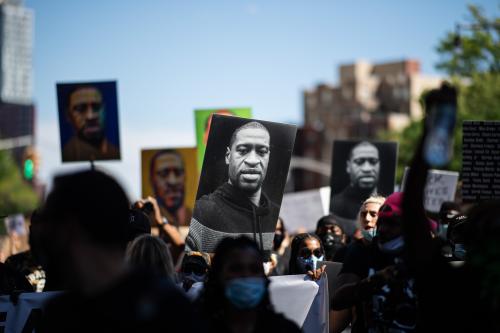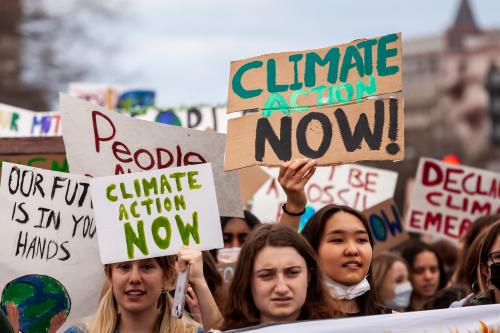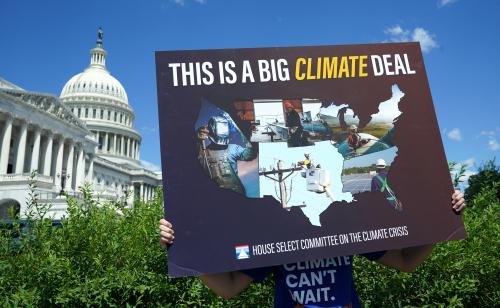We are living through a summer of climate shocks. Around the world, heat records on land and sea have shattered and severe storms fueled by heatwave-warmed waters have caused 1000-year floods. Other regions are experiencing extreme drought that is exacerbating wildfires, which are setting off air quality alerts for millions of people (including the residents in 18 states in the U.S.). With the onset of El Niño, scientists warn that this summer is only the beginning.
As the world burns, a growing radical flank of the climate movement has taken to the streets in protest. Activists are blocking traffic, marching slowly, smearing paint, throwing food, and disrupting events to bring attention to the climate crisis and the need for more aggressive climate action. Although many articles have been written about these increasingly confrontational tactics, too little is known about who the activists are and how they are connected.
My forthcoming book, Saving Ourselves: from Climate Shocks to Climate Action (Columbia University Press, 2024), investigates this growing radical flank and provides data to explain why more-and-more people are participating in civil disobedience as part of the climate movement.
Wherefore the radical flank?
Conflicts within movements sow the seeds of dissent and cultivate emergent groups within a larger movement that employ more confrontational tactics. These emergent groups are what some scholars call a “radical flank.”1 For example, a radical flank emerged in the Civil Rights Movement as activists realized they did not have the necessary access to power to make change through the legal and political systems.2 Instead, activists employed more confrontational tactics, including staged sit-ins, non-permitted marches, and even riots. In most cases, these tactics were initiated by youth-led organizations, including some with militant ideas.3 Radical flanks are common when there is conflict over tactics, targets, and timetables for action.
As climate shocks grow more severe and more common, the radical flank of the climate movement has also grown. Non-violent civil disobedience has been employed by activists to draw attention to the continuation of fossil fuel expansion while the world prepares for the next round of climate negotiations in Dubai, which is being chaired by a former fossil fuel executive.
In the past six months, climate groups have smeared paint on the casing of a Degas statue in the National Gallery of Art, sat in rocking chairs to blockade local branches of banks, rallied outside the White House, blocked traffic by slow marching on motorways, interrupted sporting events, and much more.
Although each group has a slightly different theory of change, they are all working to encourage governments to do more to address the climate crisis and stop supporting fossil fuel expansion.
To understand who participates in civil disobedience, what motivates them, and how they are connected, we surveyed individuals working with climate groups that are employing non-violent civil disobedience as a tactic. For our study, we reached out to all of the groups that were involved in the action at the White House Correspondent’s Dinner in Washington, D.C. in April 2023 and asked them to share an anonymous link to our survey with their contact lists. In the end, data were collected from a sample of 60 activists who were connected to groups participating in civil disobedience in the U.S. in spring 2023. By focusing on the groups involved in one specific action and mapping out how the activists and organizations are connected, our results tell us a lot about how the radical flank of the climate movement is structured more generally.
Who are these activists?
Similar to my previous work on activists involved in the American Resistance and the Youth Climate Movement, activists are majority female (61%), predominantly white (93%), and highly educated (91% have completed college and one-third had completed a JD, MD, or PhD degree). Despite the youth-focused media reports, activists engaging in civil disobedience as part of the climate movement tended to be middle-aged, with an average age of 52 (25% reported being 69 or older).
Similar to recent research on the climate movement, these climate activists are motivated by a range of issues to engage in climate activism. Their top motivations were Climate Change (83%), Racial Justice (58%), and Income and Wealth Inequality (46%).
How are these activists connected?
Figure: Affiliation Network of Climate Activists’ Organizational Ties
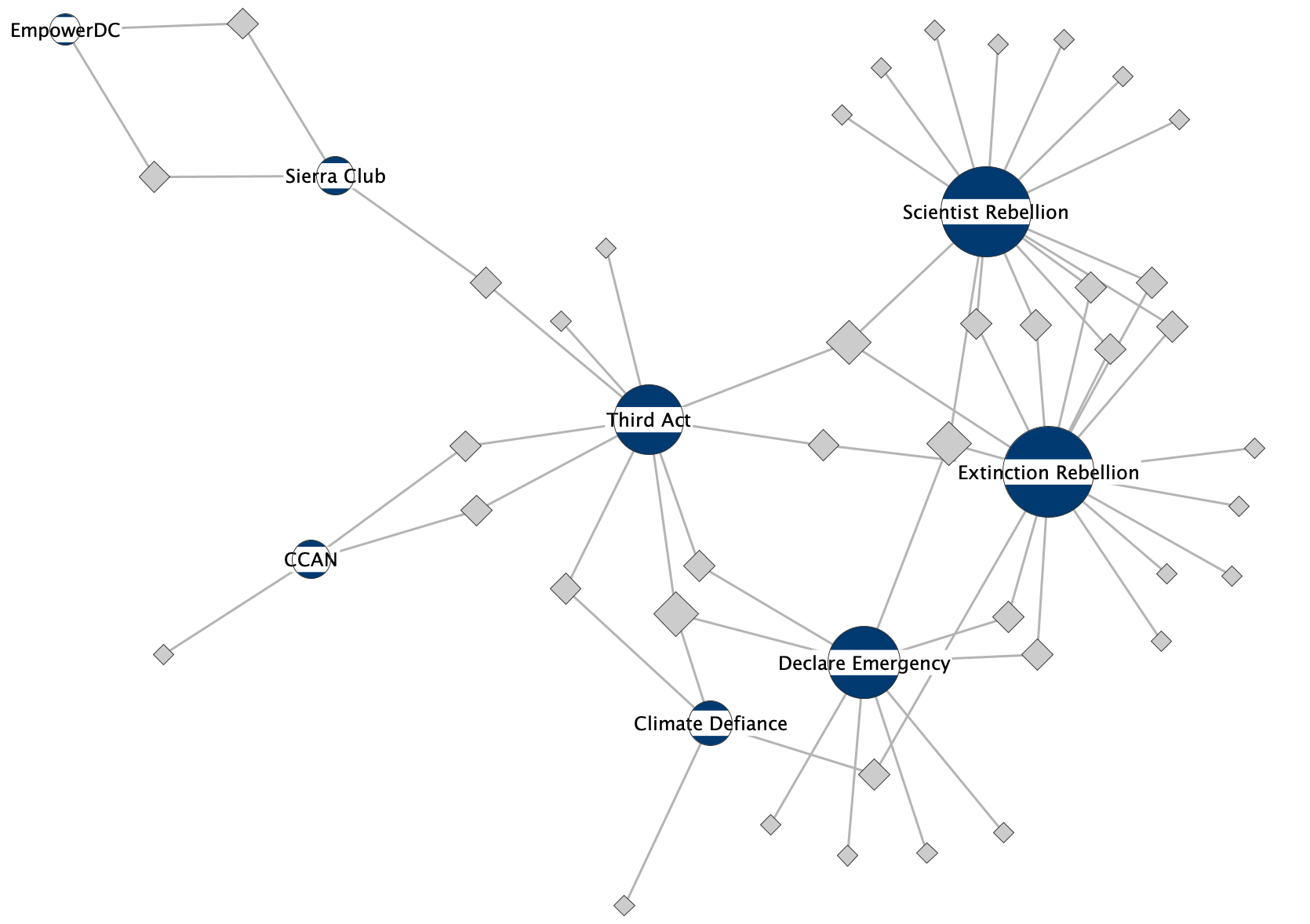
(Analysis based on data collected by authors, July 2023)
In the figure above, we map out activists’ reported organizational networks to understand how they are connected. Respondents were asked to indicate up to three organizations they were working with to coordinate their activism. To make this figure more readable, we removed activists with no connection to organizations (isolates), as well as any organizations that were only listed by one individual. In the constructed figure above, gray links connect each individual activist (the gray diamonds) to the organizations they listed (blue circles). The organizations and individual activists are sized based on their degree of centrality in the network: the largest organizations and individuals are those that are most popular in the network, revealing key activists and organizations engaging in confrontational activism around climate change.
The figure shows how the network of climate activists engaging in civil disobedience is relatively distributed; there is no one organization leading this network. The most popular groups in the network in spring 2023 were Scientists Rebellion and Extinction Rebellion. Extinction Rebellion has been coordinating civil disobedience to disrupt business-as-usual and raise awareness about the climate crisis since it began in the U.K. in 2018. Today, the organization reports 1,022 groups in 87 countries in its decentralized network of activists. Scientists Rebellion was formed by scientists inspired by Extinction Rebellion in 2020. They are well known for participating in protests wearing white lab coats and gained attention in December 2022 when two activists disrupted a plenary session at the American Geophysical Union annual conference. Other prominent groups in the network are: Declare Emergency, which is known for its action at the National Gallery of Art; and Third Act, which organized seniors to sit in hand-painted rocking chairs in front of bank branches as part of their “rocking chair rebellion” this past spring.
It is worth mentioning here that Climate Defiance is a smaller node in the network. The group was started in April 2023 and claims the coordinated protest at the White House Correspondents’ Dinner as its first action. Since April, it has grown substantially and has organized numerous confrontational actions at political events, including interrupting talks by members of the Biden Administration. The figure also shows that there are a number of activists that serve as bridges between the various climate groups coordinating non-violent civil disobedience.
As the climate crisis worsens and more-and-more concerned activists lose confidence that institutional politics can address the problem, the radical flank will grow. These findings suggest that activists who choose to join the radical flank of the climate movement have many opportunities to participate through a range of organizations. Joining one organization that is connected through a dense network of engaged activists will lead to more coordinated actions across the entire movement. For those who believe they can stop this wave of confrontational activism by prosecuting one group or imprisoning one activist, think again.
-
Footnotes
- Haines, “Black Radicalization and the Funding of Civil Rights”; McCammon, Bergner, and Arch, “‘Are You One of Those Women?’ Within-Movement Conflict, Radical Flank Effects, and Social Movement Political Outcomes”; Simpson, Willer, and Feinberg, “Radical Flanks of Social Movements Can Increase Support for Moderate Factions.”
- See McAdam, Political Process and the Development of Black Insurgency, 1930-1970, for a full discussion.
- E.g. Carmichael and Hamilton, Black Power: Politics of Liberation in America; McAdam, Political Process and the Development of Black Insurgency, 1930-1970,; Morris, The Origins of the Civil Rights Movement; Bloom and Martin Jr, Black against Empire; Bloom, “The Dynamics of Repression and Insurgent Practice in the Black Liberation Struggle.”



